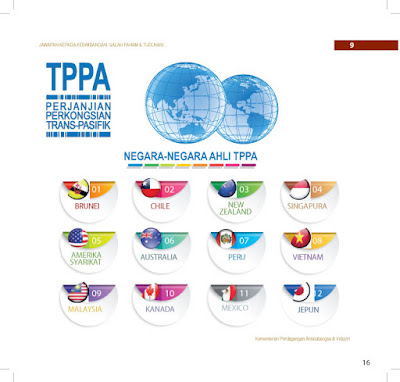The Trans-Pacific Partnership Agreement (TPPA) builds on the FTA signed by the Pacific 4 (P4) countries, New Zealand, Singapore, Chile and Brunei Darussalam. The P4 FTA was signed in 2005 and came fully into force in 2009.
The P4 was then expanded and the TPPA negotiations began with the entry of the United States, Australia, Peru, and Vietnam in March 2010. The scope has been expanded to include new issues with the goal to develop a comprehensive and high standard agreement.
The TPPA is an initiative to establish an FTA among 12 countries with a market of 800 million people with a combined GDP of USD 27.5 trillion.
There are 21 working groups which have been established to undertake negotiations on:
1) Market Access;
2) Technical Barriers to Trade;
3) Sanitary and Phytosanitary Measures;
4) Rules of Origin;
5) Customs Cooperation;
6) Investment;
7) Services;
8) Financial Services;
9) Telecommunications;
10) E-Commerce;
11) Business Mobility;
12) Government Procurement;
13) Competition;
14) Intellectual Property;
15) Labour;
16) Environment;
17) Capacity building;
18) Non-conforming measures;
19) Trade Remedies;
20) Horizontal issues; and
21) Legal and Institutional.
Countries participating in the negotiations to establish the TPPA, are free to table proposals on any of the issues being negotiated. All proposals however, have to be agreed by consensus.


































































































0 Comments
بِسْمِ اللَّهِ الرَّحْمَنِ الرَّحِيم
السلام عليكم ورحمة الله وبركاته
PenaMinang.com tidak bertanggungjawab terhadap komentar yang diutarakan melalui ruangan ini. Ia pandangan peribadi pemilik akaun dan tidak semestinya menggambarkan pendirian sidang redaksi kami. Segala risiko akibat komen yang disiarkan menjadi tanggungjawab pemilik akaun sendiri.
Segala caci maki, kutukan, fitnah adalah antara anda dengan ALLAH Azza Wa'jal. Berilah komen dan kritikan yang membina. Insyallah kami akan cuba membalas komen-komen anda.